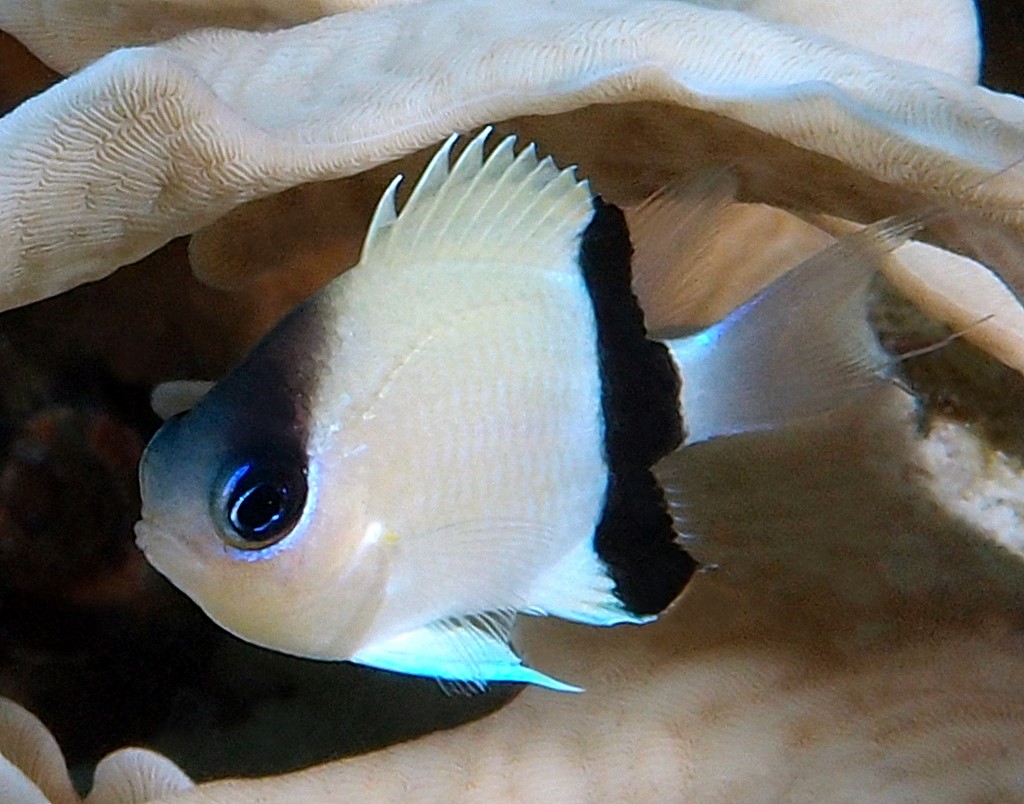PYCNOCHROMIS RETROFASCIATUS - (WEBER, 1913)
Actinopterygii (Gigaclass) > Actinopteri (Class) > Teleostei (Subclass) > Blenniiformes (Order) > Pomacentridae (Family) > Chrominae (Subfamily) > Pycnochromis (Genus)
Poisson demoiselle à barre noire, Black-bar chromis, Blackbar puller, Kuroobi-suzumedai, クロオビスズメダイ, 黑带光鳃雀鲷,
Synonymes
Chromis retrofasciata (Weber, 1913)
Chromis retrofasciatas (Weber, 1913)
Chromis retrofasciatus (Weber, 1913)
-------------------------
Description
Dorsal spines (total): 12; Dorsal soft rays (total): 12-13; Anal spines: 2; Anal soft rays: 12-13; Pectoral fin rays: 15-16; Lateral-line scales: 12; Gill rakers: 24-26; Body depth: 1.8-2.0 in SL. Caudal-fin lobes ending in two filaments. Max. length: 6.0 cm SL. Depth range: 3 - 120 m, usually: 5 - 65 m.
Color
Body light tan to yellowish brown with a prominent black bar posteriorly on body. The caudal fin and caudal peduncle is white.
Etymology
Pycnochromis: from ancient Greek, puknós = dense, compact, thick. Referring to “very smooth” head of Pycnochromis vanderbilti, the “edges of the suborbitals, preopercle and opercle little distinct” + from chromis: from Greek, chroemo = to neigh. A name dating to Aristotle, referring to a drum (Sciaenidae) and its ability to make noise; Later applied to this damselfish and subsequently expanded to embrace dottybacks, cichlids and wrasses (all perch-like fishes once thought to be related).
retrofasciatus: from Latin prefix, retro-, back + from Latin, fascia, fascio = bundled, banded + from Latin suffix, -inus = pertaining to. Referring to chocolate-colored bar at posterior end of body and caudal-fin base.
Original description: Chromis retrofasciatus Weber, 1913 - Type locality: Kur Island, Indonesia, Siboga station 250, depth 27 meters.
Distribution
Western Pacific: Sabah (Malaysia), Philippines and New Guinea, east to Fiji, north to Ryukyu Islands (Japan), south to Queensland (Australia) and New Caledonia.
Biology
Adults inhabit coral-rich areas of clear lagoon and seaward reefs. They occur singly or in small groups and remains close to thickly branching coral shelter. Oviparous, distinct pairing during breeding. Eggs are demersal and adhere to the substrate. Males guard and aerate the eggs.
Last update: 31, March 2024
Poisson demoiselle à barre noire, Black-bar chromis, Blackbar puller, Kuroobi-suzumedai, クロオビスズメダイ, 黑带光鳃雀鲷,
Synonymes
Chromis retrofasciata (Weber, 1913)
Chromis retrofasciatas (Weber, 1913)
Chromis retrofasciatus (Weber, 1913)
-------------------------
Description
Dorsal spines (total): 12; Dorsal soft rays (total): 12-13; Anal spines: 2; Anal soft rays: 12-13; Pectoral fin rays: 15-16; Lateral-line scales: 12; Gill rakers: 24-26; Body depth: 1.8-2.0 in SL. Caudal-fin lobes ending in two filaments. Max. length: 6.0 cm SL. Depth range: 3 - 120 m, usually: 5 - 65 m.
Color
Body light tan to yellowish brown with a prominent black bar posteriorly on body. The caudal fin and caudal peduncle is white.
Etymology
Pycnochromis: from ancient Greek, puknós = dense, compact, thick. Referring to “very smooth” head of Pycnochromis vanderbilti, the “edges of the suborbitals, preopercle and opercle little distinct” + from chromis: from Greek, chroemo = to neigh. A name dating to Aristotle, referring to a drum (Sciaenidae) and its ability to make noise; Later applied to this damselfish and subsequently expanded to embrace dottybacks, cichlids and wrasses (all perch-like fishes once thought to be related).
retrofasciatus: from Latin prefix, retro-, back + from Latin, fascia, fascio = bundled, banded + from Latin suffix, -inus = pertaining to. Referring to chocolate-colored bar at posterior end of body and caudal-fin base.
Original description: Chromis retrofasciatus Weber, 1913 - Type locality: Kur Island, Indonesia, Siboga station 250, depth 27 meters.
Distribution
Western Pacific: Sabah (Malaysia), Philippines and New Guinea, east to Fiji, north to Ryukyu Islands (Japan), south to Queensland (Australia) and New Caledonia.
Biology
Adults inhabit coral-rich areas of clear lagoon and seaward reefs. They occur singly or in small groups and remains close to thickly branching coral shelter. Oviparous, distinct pairing during breeding. Eggs are demersal and adhere to the substrate. Males guard and aerate the eggs.
Last update: 31, March 2024
